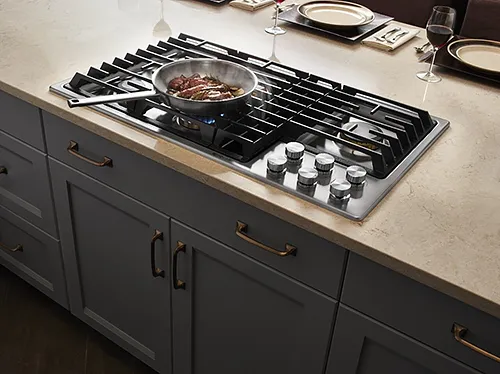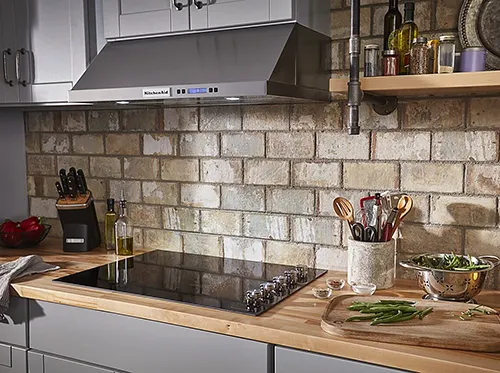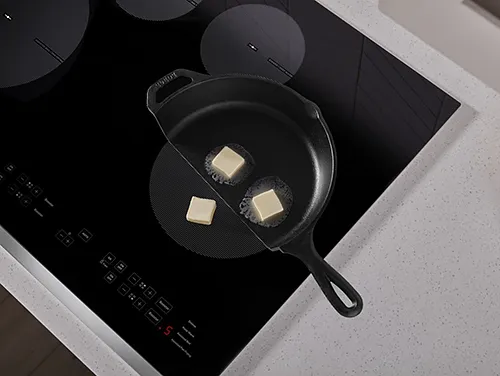How Different Types of Cooktops Compare
by Rachel Lyon, Editorial Director for The House Designers
The cooktop is the kitchen workhorse in most households, getting far more use than the oven on average. It also requires a fair amount of active participation—whoever’s cooking has to keep an eye on things throughout the process, making sure to adjust the heat, stir pots, etc., to help dishes turn out well in the end. With all the time you’ll spend preparing meals with your cooktop, it’s a good idea to invest in a model equipped to offer the best experience for your needs. Start with the basics—do you know whether you want gas, radiant electric, or induction heating? Here’s a breakdown of what each has to offer!
While we’ll focus on cooktops here, the same rules apply for ranges. Gas and electric ranges have been around a while, and now induction ranges are making their way into the market as well. A range offers a more compact cooking station ideal for smaller kitchens and tighter budgets, but the functionality of the stovetop is essentially the same as a cooktop.
The
JennAir® Euro-Style 36” JX3™ Gas Downdraft Cooktop has burners ranging from 5,000 to 17,000 BTUs to expertly handle delicate and high-power cooking tasks. And with the built-in ventilation that pulls smoke and steam down beneath the surface, it doesn’t need an overhead hood.
Gas Cooktops
The traditional choice, gas cooktops are preferred by professional chefs and homeowners who demand instant and highly adjustable heat control. Gas stands far above electric radiant for many because it’s consistent; you set the flame where you want it, and you don’t have to wait for a heating element to come up to temperature slowly. The burners on gas cooktops come in a variety of sizes to efficiently heat all kinds of pots and pans, and some will have higher outputs for tasks that require more energy. No matter the recipe, somebody familiar with cooking with gas is sure to get great results!
Installing a gas cooktop requires a bit more planning than other types. First of all, it needs to connect to a gas line as well as a 120V electrical outlet. If you plan to renovate, consult with a professional before making any decisions, because there might be placement limitations that aren’t obvious at first glance. The higher heat output of open flame also needs to be paired with a more powerful hood for ventilation, so keep that in mind when shopping. Given their complexity, gas cooktops typically cost more to purchase and install than electrical models, but they cost less to use over time because gas is less expensive than electricity when it comes to generating heat.
Of course, gas does have some drawbacks. Many families with children and/or pets opt for electric alternatives because open flames pose more risks. Individuals with lung conditions are also advised against gas because it can exacerbate breathing problems; irritating compounds are released while burning and also in small amounts even when all the burners are off. If gas isn’t right for you, don’t worry—there are other great cooktops out there!
Radiant Electric Cooktops
A popular option for decades now, electric cooktops come in two basic types—coil and glass top. Coils are the original electric cooking solution and are better if you need to stick to a budget, but most homeowners these days prefer the sleek look, easier cleanup, and specialized elements offered by a smooth surface. In either case, radiant electric cooktops work the same way; an electric current is run through a resistant metal coil to generate heat. These cooktops are simple for anybody to operate and don’t pose any potential health risks with proper use, so they make a great choice for the whole family.
Electric cooktops come in all shapes and sizes and with a variety of different features, so be sure to compare the finer details before making your purchase. These cooktops are the most budget-friendly type to buy and only require a dedicated 220V outlet to install, but they cost the most to use due to how they work—generating heat with electricity through a resistance coil is inherently inefficient. People living in areas with expensive electricity often invest in other types of cooktops to save money for the long term.
Other than the potentially higher costs, some homeowners avoid radiant electric cooktops because they lack precision. They heat and cool slowly, so it’s more difficult to control the temperature and you won’t get the same results as you would with gas or induction. This might sound like a serious disadvantage, but it’s not really—most people aren’t as picky as the professionals and can make wonderful meals with an electric cooktop.
With a partial skillet for illustrative purposes, you can see how this
Whirlpool® 30-Inch Induction Cooktop melts the butter in the pan while the pat on the burner remains cold. Induction cooking heats cookware directly, so it’s efficient and doesn’t lose energy to the environment.
Induction Cooktops
Offering the best qualities of gas and electric, induction cooktops are the hot new thing. Rather than burning fuel or using a resistance element to generate heat, induction works by generating an electromagnetic field to heat up magnetic cookware—like cast iron or other pots and pans that have a magnetic layer. This means that all the heat goes into what you’re cooking; it doesn’t radiate away from the heating element or even warm the surface of the cooktop. You can adjust the temperature quickly and precisely to achieve meticulous results like a pro, but most people love how easy cleanup is with the smooth surface that literally can’t burn spills!
Being relatively new, induction cooktops are still considered a premium appliance. Only recently have they become accessible for more modest kitchens and budgets, but you can bet you’ll see more of them in the future! If you’re interested in cooking with induction, you should know that it requires a dedicated 240V outlet and induction-compatible cookware. So, you may need to bring in an electrician and/or replace your existing pots and pans. If you can swing the expense up front, induction’s remarkable efficiency will pay off going forward.
While induction cooking is safe for most people, it can be dangerous for anybody with a pacemaker, internal defibrillator, or insulin pump. Magnetic fields interfere with and can disable these devices, so people with electronic implants should never operate an induction cooktop. Most manufacturers say they can keep a distance of a few feet safely, but with plenty of other great cooktop options available, there’s no reason to risk it if you have a family member with a medical implant.
If you’re looking for the perfect appliances to complete your kitchen, explore Whirlpool®, KitchenAid®, and JennAir®! These brands offer a wide range of gas, electric, and induction cooktops across all price points, so rest assured you’ll find a cooking solution to suit your needs. And if in doubt, you can visit a showroom or contact their helpful customer care teams for assistance!



.png)
.png)




